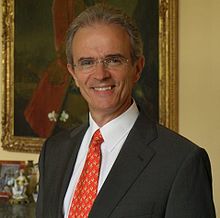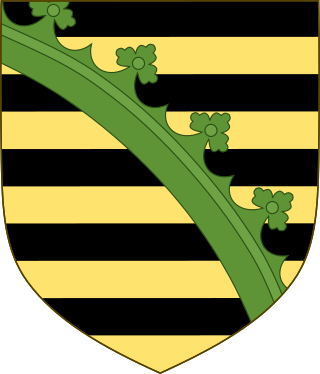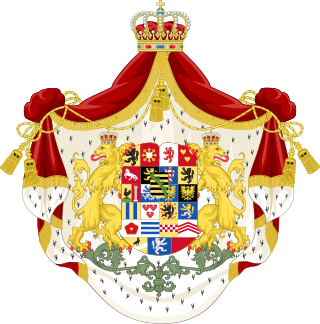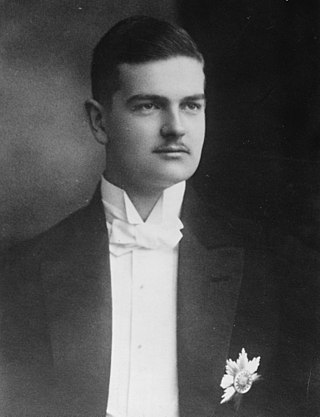Early life and career
Born in Munich as Alexander Afif, he is the eldest son of Roberto Afif, Dr. Jur (mentioned as Catholic nobleman of Lebanon) and Princess Anna of Saxony. At birth Alexander did not possess rights to the abolished throne of Saxony (which was regulated by semi-Salic succession) as his parents’ marriage did not meet the equal marriage requirements of the Saxon house law. [1] Alexander legally assumed the surname Prinz von Sachsen-Gessaphe on 25 August 1972. [2]
Alexander grew up mainly in Mexico eventually taking over the running of a logistics company from his father. [3] He married Princess Gisela of Bavaria (b. 10 September 1964), firstly civilly at Mexico City 3 April 1987 and then religiously at Andechs Abbey 29 August 1987. They have four children: [1]
- Prince Georg Philipp of Saxony (b. 24 May 1988, Mexico City)
- Prince Moritz Gabriel of Saxony (b. 14 Sep 1989, Mexico City)
- Prince Paul Clemens of Saxony (b. 23 Mar 1993, Mexico City)
- Princess Maria Teresita of Saxony (b. 7 July 1999, Dresden), married on 27 May 2023 in Ivoy-le-Pré, France, Count Béryl de Saporta
His marriage with Gisela enhanced his dynastical potential in the eyes of his maternal uncle, the childless Margrave who was left without a clearly eligible heir when Alexander's first cousin, the young Prince Johannes of Saxe-Coburg and Gotha (1969–1987), was killed in August 1987 in a climbing accident.
In February 2003 Alexander began to work in attracting worldwide investors to Saxony, he also worked as an advisor to Georg Milbradt, Minister-President of Free State of Saxony, leaving with Milbradt in 2008. In the Summer of 2004, he received German citizenship. In 2009 he left Germany to resume living in North America (Mexico). [3] In July 2012 Alexander gave a controversial interview where he criticised what he saw as ingratitude and a lack of etiquette on the part of the people in the former East Germany (which includes Saxony). [4]
Royal House of Saxony
The headship of the Royal House of Saxony is a matter of dispute in the Saxon Royal Family. The conflict stems from the fact that the last undisputed head of the house Maria Emanuel, Margrave of Meissen, and his brother Albert had no children whereas their first cousin, Prince Timo, had children (including Rüdiger) who were not deemed members of the Royal House of Saxony because of Timo's unequal marriage. [1] [5]
The first designated dynastic heir of Maria Emanuel was his and Albert's nephew Prince Johannes of Saxe-Coburg and Gotha, only son of their youngest sister Princess Mathilde of Saxony by her marriage to Prince Johannes Heinrich of Saxe-Coburg and Gotha, dynast of a ducal branch of the House of Wettin senior patrilineally to the royal branch. [1] After the early death of Prince Johannes, the childless Maria Emanuel then considered as potential heir another nephew, Alexander Afif, the eldest son of his elder sister Princess Anna of Saxony and her husband Roberto Afif, despite the Afif-Saxony marriage being contrary to the traditional laws of the House of Saxony which required equal marriages for descendants to inherit dynastic rights. [1] [6] On 14 May 1997 the Margrave of Meissen proposed his nephew Alexander Afif as heir and drew up a document that was signed by the other male and female members of the Royal House (including previously non-dynastic spouses of princes) setting out that Alexander would succeed on his death. The document was signed by: Anastasia, Margravine of Meissen, Prince Albert and his wife, née Elmira Henke, Prince Dedo (for himself, his brother Prince Gero and for their stepmother née Virginia Dulon - his brother Prince Timo had died in 1982), the Princesses Maria Josepha, Anna and Mathilde, and Prince Timo's third wife, née Erina Eilts. [7] Two years later on 1 July 1999 the Margrave adopted his nephew Alexander Afif, who had used the title Alexander, Prince of Saxe-Gessaphe since 1972, [2] based on his assumed patrilineal descent from the once-sovereign Lebanese Assaf (or Gessaphe ) dynasty, [1] [8] Emirs of Keserwan, through the Maronite Catholic Cheikhs Afif of Bkassine.
The 1997 agreement proved to be controversial and in the summer of 2002 three of the signatories, Princes Albert, Dedo and Gero (the latter consented via proxy but had not personally signed the document) [9] retracted their support for the agreement. [10] The following year Prince Albert wrote that it is through Prince Rüdiger and his sons that the direct line of the Albertine branch of the House of Wettin should continue, and thus avoid becoming extinct. [11] Until his death, however, the Margrave, as head of the former dynasty, continued to regard his nephew and adopted son, Prince Alexander, as the contractual heir entitled to succeed.
Immediately following the death of Maria Emanuel in July 2012, Prince Alexander, citing the 1997 agreement, assumed automatically the title of Margrave of Meissen. Prince Albert assumed also, unilaterally, the position of head of the Royal House of Saxony. However, this claim is contradicted by Albert himself in his final interview, given after the funeral, where he states that he needs recognition as Margrave of Meissen. [12] P [13] Albert, Margrave of Meissen died at a hospital in Munich on 6 October 2012 at the age of 77.
Prior to the requiem for Margrave Maria Emanuel, Rüdiger, who had sought to be recognised by his cousin as a dynastic member of the House of Saxony but was refused, conducted a demonstration outside the cathedral with Saxon royalists in protest against the late Margrave Maria Emanuel's decision to appoint Alexander as heir. [14] The family website of Prince Rüdiger states prior to his death Albert determined Rüdiger to be his successor and instituted a clear succession plan. [15] On this basis following Albert's death Prince Rüdiger assumed the headship of the house, [16] having stated "We will not accept Prince Alexander as head of house". [17]
In a joint statement of 23 June 2015, the heads of the three remaining branches of the senior Ernestine line of the House of Wettin, Michael, Prince of Saxe-Weimar-Eisenach, Andreas, Prince of Saxe-Coburg and Gotha and Konrad, Prince of Saxe-Meiningen, declared that, according to the historical princely and house laws of the House of Wettin, Alexander Prinz von Sachsen (formerly Alexander Afif, aka Alexander Prinz von Sachsen-Gessaphe), bearing the name Prinz von Sachsen by adoption, is not a noble and bears a non-noble name, is not a member of the House of Wettin, nor did he succeed the Margrave Maria Emanuel of Meissen, Prince and Duke of Saxony, at his death on 23 July 2012 as head of the Albertine branch of the House of Wettin (the Royal House of Saxony), nor have the right to assume the title of the Head of House, Margrave of Meissen." [18]











